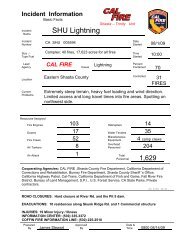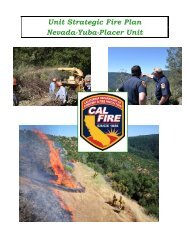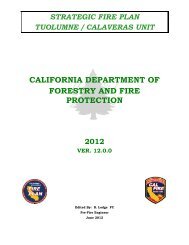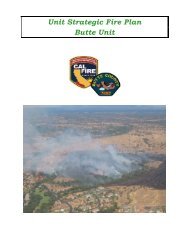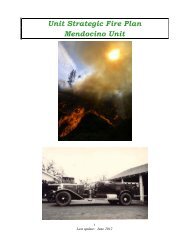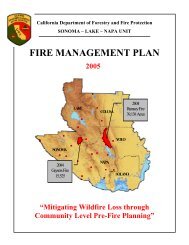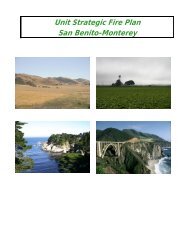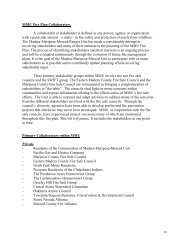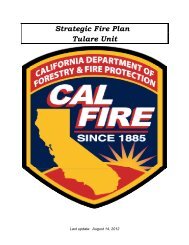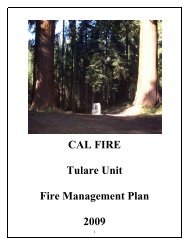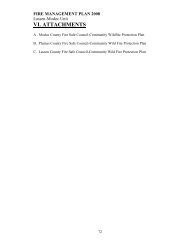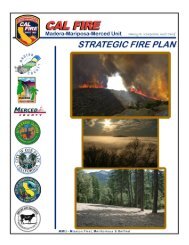Nevada-Yuba-Placer Strategic Fire Plan 2011 - Board of Forestry ...
Nevada-Yuba-Placer Strategic Fire Plan 2011 - Board of Forestry ...
Nevada-Yuba-Placer Strategic Fire Plan 2011 - Board of Forestry ...
Create successful ePaper yourself
Turn your PDF publications into a flip-book with our unique Google optimized e-Paper software.
(9000’). Topographic influences<br />
and aspect coupled with the elevation changes provide NEU with some <strong>of</strong> the most diverse<br />
landscapes in the State. The Mediterranean climate provides sufficient precipitation and growing<br />
season and the highly productive soils sustain significant plant growth. Annually, and over time,<br />
the total biomass production is significant.<br />
The agricultural grassland <strong>of</strong> the Sacramento Valley and the oak woodlands <strong>of</strong> the foothills are<br />
dominated by grass fuels. The density <strong>of</strong> grassland fuel is largely dependant on the quantity and<br />
timing <strong>of</strong> annual rainfall. Grass fuels are an annually critical fire concern. <strong>Fire</strong>s in these<br />
potentially dense, light flashy fuels commonly result in rapid rates <strong>of</strong> spread and normally<br />
consume a large number <strong>of</strong> acres.<br />
The oak woodlands include a significant mixed brush component on east and south facing<br />
slopes. The oak woodlands at the lower elevations develop into montane hardwood-conifer. The<br />
primary dividing element is elevation change. Areas above 1200’ elevation typically sustain<br />
forest cover; areas below typically sustain oak woodlands with brush and grass. Topographic<br />
influences and soil variations provide a mosaic where cover types are mixed and extend beyond<br />
the typical elevation dividing line. Locations above 3000’ transition to sierra mixed conifer.<br />
Annual biomass production from these timber fuel types is impressive ranging from 40 to 50<br />
ft3/ac/year. Much <strong>of</strong> this volume occurs in the form <strong>of</strong> light fuels, needles and bark. Fuel loading<br />
<strong>of</strong> available fuels is largely a function <strong>of</strong> winter storm and pest damage. Fuels reach critical<br />
moisture levels under normal weather conditions and any ignition can result in large, costly and<br />
damaging fires. Above 5500’ elevation timber types transition to true fir and sub-alpine conifer<br />
where environmental factors generally limit biomass production. Juniper and sage brush types<br />
dominate the higher elevations and eastside rain-shadow lying east <strong>of</strong> the crest<br />
Weather and Topography<br />
The topography within NEU changes drastically from the flat lands <strong>of</strong> the Sacramento Valley<br />
below the 500’ elevation to the steep upper slopes <strong>of</strong> the Sierra <strong>Nevada</strong> above 7,000’. The<br />
landscape aspect trend is generally west facing but interior and lateral slopes are common in all<br />
direction. Flat lands <strong>of</strong> the valley give way to rolling hills that eventually become steep innergorge<br />
in mid to higher elevation watersheds.<br />
Predominant weather patters in NEU are characterized by hot dry summers and mild to cool<br />
winters. The precipitation in lower elevations is generally in the form <strong>of</strong> rain with accumulations<br />
approximating 17 to 20 inches annually. Higher elevations commonly receive annual snow<br />
accumulations <strong>of</strong> 10 to 15 feet. Predominate winds are southwest but commonly becomes<br />
north to northeast following weather systems.<br />
Annually fire weather conditions become critical in late July through October. Red Flag warnings<br />
are common throughout the summer and largely attributed to low relative humilities and high<br />
north winds. An average summer day is 85-95 degrees, winds southwest 0-7 with RH <strong>of</strong> 20-25<br />
percent. Under these common conditions the ignition potential and likelihood <strong>of</strong> a fire growing<br />
into a significant event is high.<br />
<strong>Fire</strong> History<br />
Cal <strong>Fire</strong> strives to extinguish 95% <strong>of</strong> all wildland fires at 10 acres or less. For those few fires<br />
that exceed 10 acres, costs <strong>of</strong> suppression and value losses grow exponentially.<br />
The <strong>Nevada</strong>-<strong>Yuba</strong>-<strong>Placer</strong> Unit’s (State) resources are allocated throughout the 3-county area in<br />
a way that is expected to keep State wildland fires small, providing maximum protection for life,<br />
property, and the environment.<br />
- 12 –



